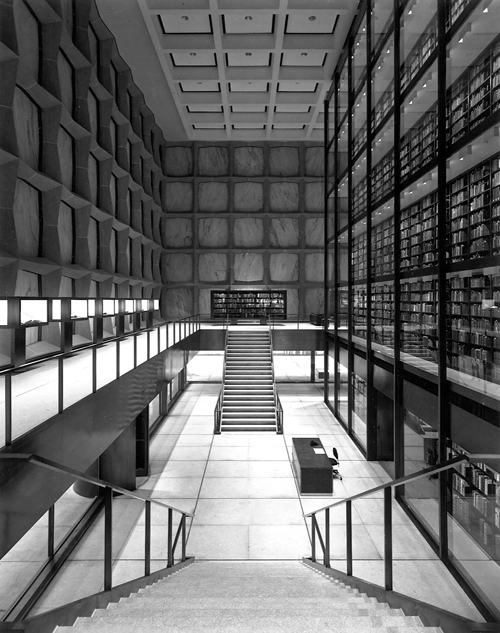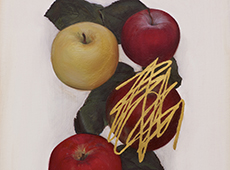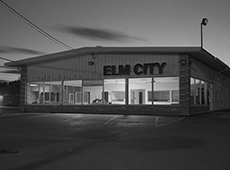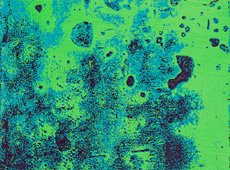The print—naked without the frame and the context of a formal space surrounding it—quickly succeeds or fails. Instead of looking at a great Robert Adams photograph, I’m simply looking at a print on a table, in the exact same way that I look at my own work, scrutinizing for flaws and moments of salvation.

Photo courtesy Beinecke Rare Book and Manuscript Library, Yale University.
Back in August I had a transformative experience. I went up to Yale University for the day and spent time with three curators of vast collections of books and photographs at the Haas Fine Arts Library, Yale University Art Gallery and Beinecke Rare Books Library. The primary purpose of my visit was to view the one and only set of prints of Skogen, Robert Adams’ new series of abstract photographs, that he made only for Yale.
A few years ago, I didn’t know it was possible to view works of art like this unmediated. When I published my first book, I began conversations with special collections librarians at many institutions and have learned of incredible opportunities to request specific works of art to request from storage and view in person.
There is no comparison to seeing the prints of a great master up close, without a guard standing behind you, without glass between you. The print—naked without the frame and the context of a formal space surrounding it—quickly succeeds or fails. Instead of looking at a great Robert Adams photograph, I’m simply looking at a print on a table, in the exact same way that I look at my own work, scrutinizing for flaws and moments of salvation.
I’m not sure how often it is acknowledged—that dressing up a piece of art with a frame, giving it space to breath on a wall and in space, and surrounding it with other well-intended pieces—no doubt, gives the individual piece greater weight than it may deserve. It’s an important skill to cultivate, to imagine the single work that lies on a table in one’s studio, presented formally in a show.
While viewing and discussing the Skogen prints with the Curator of Photography, Joshua Chuang, at Yale’s Gallery of Art, he said, “Hang on a sec, I want to show you something.” He returned carrying two Ilford paper boxes. Upon opening them I immediately recognized Lee Friedlander’s prints of Central Park. What a revelation to see the prints after viewing them so often on the screen. It was made even more meaningful because I was working through lingering questions about my own work in Central Park.
Before my meeting at the Museum, I had the pleasure of meeting a librarian at the Haas Fine Arts Library. We talked about the collection, the library itself, and the access that students, scholars and the public has to this amazing collection. At one point, the librarian pointed to a wall that was displaying part of their collection of books just on typography. She mentioned the availability for teachers to bring their students to the library, request a number of books from the collection, and use one of their meeting spaces to discuss and learn from the works. Again, an astounding resource that I’m sure is not utilized as much as it should be.
The print—naked without the frame and the context of a formal space surrounding it—quickly succeeds or fails. Instead of looking at a great Robert Adams photograph, I’m simply looking at a print on a table, in the exact same way that I look at my own work, scrutinizing for flaws and moments of salvation.
My last appointment for the day was at the Beinecke Rare Books Library. The building, designed by Gordon Bunshaft of Skidmore, Owings and Merrill in 1963, is an example of how architecture can make art out of space. As one of the largest buildings in the world devoted entirely to rare books and manuscripts, the library has a central tower of glass that can hold 180,000 volumes and underground stacks for over 600,000 volumes; it now contains about 500,000 volumes and several million manuscripts. The Beinecke’s collection is open to researchers simply by registering online.
Yale is not the only institution to offer access to their collection. Many of the many of the major museums and libraries allow the public to request works for viewing. Richard Benari, the co-editor of this journal, often describes a similar experience he had viewing a set of Jasper Johns lithographs at the Cunningham Center at Smith College’s Museum of Art. I have heard him credit his visit there for reconnecting him with art, giving him a better sense of materials and process and enabling a deeper understanding of the direction he wanted his own art to go in.
The process by which to request materials is shockingly easy. To visit the Cunningham Center, you can simply search their online site for works of interest and send an e-mail with the date and time you prefer including the object number, artist’s name, and title. You can request up to fifteen works per visit. Unsure about what you’d like to see or more interested in a topic than one artist or work? You can have staff make selections for you. The Watson Library at the Metropolitan Museum of Art is another fantastic resource for the public. You do not even need to pay Museum admission to visit the library (not that anyone really knows what the entry fee is to the Met these days). A simple online registration will get you started. From there, you can request materials online, up to 10 items at a time. Your requests will be held for you on open shelves in the Library for one week. The New York Public Library describes itself as, “The most accessible print room in New York City, the Print Collection of The New York Public Library encompasses over 200,000 prints along with a specialized reference collection of over 15,000 volumes on the history of prints and printmakers.” Materials are available through the Prints and Photographs Study Room with an admission card, during public viewing hours. You can make an appointment with a librarian online and select specific areas of interest. At the Goldman Study Center at the Art Institute of Chicago, appointments to view selections from the collection of prints and drawings can be made by phone or e-mail. Researchers may use the Hasselblad Photography Study Center at the Museum of Modern Art to consult photographs from the Museum’s collection by making an appointment online.
I will be traveling back up to Yale soon, to view some of the Beinecke’s extensive collection of Edward Curtis and William Jackson photographs—research for a new body of work.
Subscribe to Tilted Arc
If you like this story, please consider subscribing. We are sticklers for privacy.
We will never sell or share your e-mail address.



